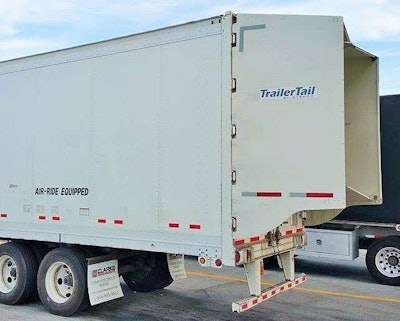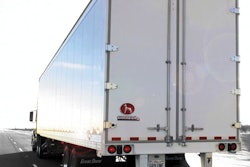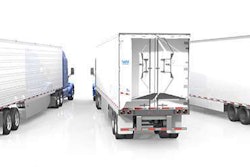 Stemco’s TrailerTail aerodynamic devices can now be mounted flush with the top of trailers for maximum aerodynamic efficiency in accordance with a five-year exemption from FMCSA.
Stemco’s TrailerTail aerodynamic devices can now be mounted flush with the top of trailers for maximum aerodynamic efficiency in accordance with a five-year exemption from FMCSA.Stemco, the manufacturer of TrailerTail aerodynamic devices, has received a five-year exemption that allows rear identification lights and rear clearance lamps to be mounted lower than currently allowed by regulations in order for TrailerTail devices to be mounted at the top of trailers, which the company says makes the devices more efficient.
Rear identification lamps are defined by the National Highway Traffic Safety Administration as three red lights to indicate the presence of a wide vehicle. Rear clearance lamps are defined as a minimum of two red lights to show a vehicle’s width that may not be combined with tail lights.
Stemco, in its exemption request published in June 2016, stated it has been mounting its TrailerTail devices between 1.5 and 3.5 inches below the top of the trailer, but for maximum aerodynamic efficiency, the devices should be mounted flush with the top of trailers. Stemco added in its request that relocating the lights to a lower position is “equivalent to the current lamp location on a flatbed trailer or intermodal chassis,” therefore not impacting safety.
In the Federal Motor Carrier Safety Administration’s decision to grant the exemption, the agency says rear identification lamps and clearance lamps can be moved from the top of trailers and mounted at the same level as stop lamps, tail lamps and turn signals.

FMCSA contends that because all trailers are required to have red and white reflective sheeting or reflectors to indicate that a trailer is part of a commercial vehicle rather than a passenger vehicle, the lights do not have to be positioned at the top of the trailer.
“While these conspicuity treatments are not located at or near the very top of the trailer or semitrailer, FMCSA believes that they provide a very distinctive visual pattern on the rear of trailers and semitrailers that easily enables motorists to be aware that they are approaching a large vehicle,” FMCSA says in its decision.
One group of commenters, the Transportation Safety Equipment Institute (TSEI), expressed concern that some fleets “may not have the technical expertise” to relocate the lamps to the lower position. FMCSA notes in response to this concern that it is up to each motor carrier to make sure their vehicles comply with federal regulations, including this exemption.
The exemption went into effect Wednesday, Feb. 14, and is good through Feb. 14, 2023.













